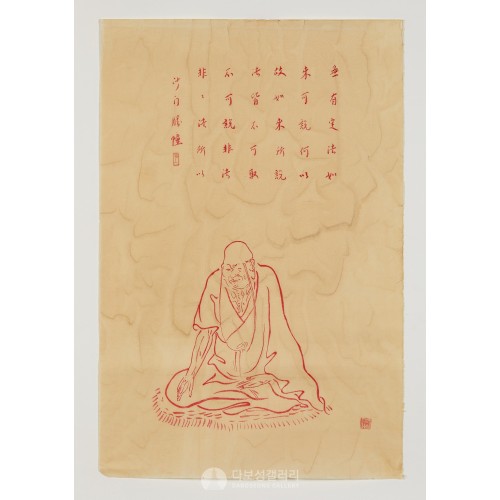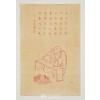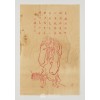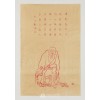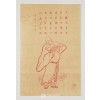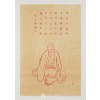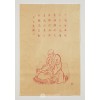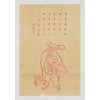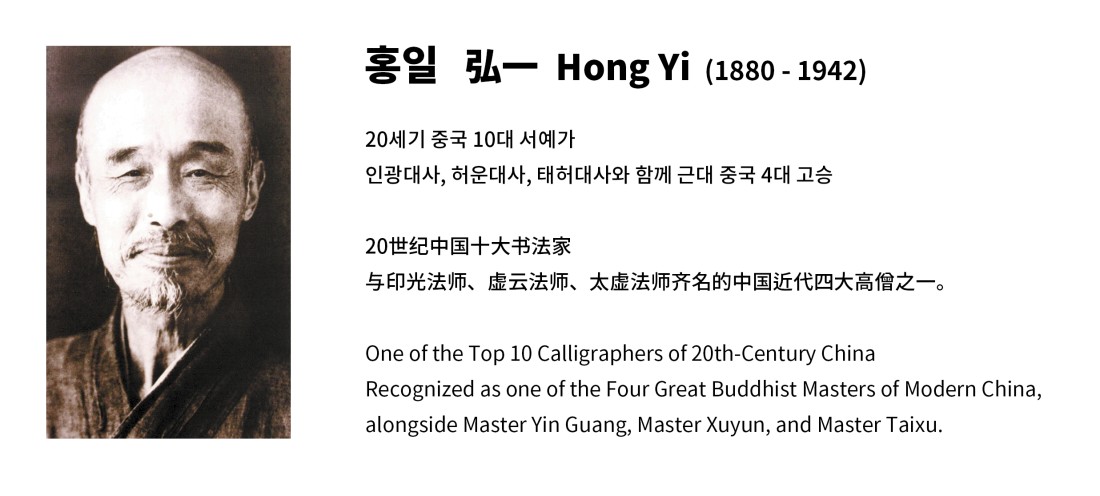본문
이 작품은 홍일법사(弘一法師, 1880~1942)가 《금강반야바라밀경(金剛般若波羅蜜經)》과 《불설관무량수불경(佛說觀無量壽佛經)》을 사경(寫經)하고 그 아래에 나한(羅漢)을 그린 것입니다. 불경마다 50점씩 모두 100점으로 구성된 이 작품은 사경과 나한도를 병치한 독특한 형식입니다.
이 작품에 등장하는 100나한은 석가모니의 가르침을 직접 들은 제자들이자 번뇌를 끊고 열반에 이른 성자들입니다. 특히 동아시아 불교에서 나한도는 주로 18나한, 108나한, 500나한 등으로 형상화되며, 승려 화가들이 수행의 의미로 자주 그렸습니다.
화면은 황색의 얇은 종이 위에 붉은 주사(朱沙) 선묘(線描)로 나한을 묘사하고 있습니다. 상단에는 불경 일부가 정갈하게 적혀 있습니다. 이 작품은 상하구성을 유지하면서도 나한의 자세, 표정, 그리고 경문의 조합을 달리하며 하나하나가 독립적인 불화이기도 합니다.
한 화면에 사경과 나한을 함께 보여주는 구성은 불교 교리의 시각화를 의도한 것으로 보입니다. 또한, 각기 다른 모습의 나한도는 홍일법사의 예술성과 신앙심이 나타난 보기 드문 작품입니다.
▣ 금강경 (金剛般若波羅蜜經)
《금강경》의 정식 명칭은 《금강반야바라밀경(金剛般若波羅蜜經)》입니다. 이 경전은 중국과 한국, 일본 등 동아시아 불교권에서 오랜 기간 필사되며 전해왔습니다. 불경에서는 형상, 개념, 집착을 초월하는 지혜를 설파하며, 모든 존재는 실체가 없고 공(空)하다는 반야 사상의 정수를 담고 있습니다.
이 경전은 5세기경 중국 승려 구마라습(鳩摩羅什)이 번역하였습니다. 그의 한역본(漢譯本)은 동아시아 불교권에 널리 유통되었고, 특히 선종(禪宗)의 근본 경전으로 중요하게 여겨졌습니다. 간결하고 논리적인 문장 구성과 함께 참된 보살은 ‘중생을 제도(濟度)하되 제도했다는 상을 갖지 않는다’는 역설적 표현을 통해 무상(無相), 무주(無住), 무득(無得)의 불이법(不二法)을 강조합니다.
내용은 석가모니와 제자 수보리 사이의 문답 형식으로 구성되어 있습니다. 모든 현상은 고정된 본질이 없고, 공(空)하다는 사상을 중심으로 전개됩니다. 특히 집착 없이 실천하는 것이 바람직한 수행의 자세임을 설명합니다. 내용상 특징은 ‘상(相)에 머무르지 말라’는 구절이 반복되며 사물의 본질이 실체가 없음을 강조하는 데 있습니다.
▣ 홍일법사 (弘一法師) (1880~1942)
1880년, 중국 톈진에서 관공서 일을 맡던 거상(鉅賈)의 집안에서 태어났습니다.
22세에 상하이 남양공학에 입학하였고, 26세에 일본으로 유학을 떠났으며, 32세에 중국으로 돌아와 톈진공업대학에서 교직을 맡았습니다.
1916년에는 항저우 서호에 있는 정혜사(虎跑定慧寺)에 들어갔고, 1918년(39세)에 출가하여 승려가 되었습니다.
법명은 인음(寅音), 법호는 홍일(弘一)이며, 속명은 이숙동(李叔同)으로 알려져 있습니다.
그는 중국에서 최초로 서양 회화를 도입한 인물이며, 처음으로 오선지를 사용해 음악 교육을 실시한 사람입니다.
또한, 중국 최초의 화극사를 설립하는 등 예술 분야에서 선구적인 역할을 했습니다. 음악, 서예, 회화, 희극 등 다양한 방면에 깊은 조예를 지녔으며, 생애 중 50년 이상을 서예와 함께했습니다.
현대 서예가들 중에서도 그만큼 열정적으로 서예의 길을 걸었던 이는 드물며, 말년에는 자신만의 독창적인 서체를 남겼습니다.
그의 작품은 중국 서예 예술사에서 탁월한 성과로 평가받고 있습니다.
그는 모든 사람에게 '홍일 스승'으로 알려졌으며, 1942년에 복건성 천주시에서 61세의 나이로 평화롭게 세상을 떠났습니다. 홍일법사는 청나라 말기의 3대 시적 스님(시승 詩僧, 시에 능한 승려) 중 한 명입니다. (다른 사람들은 수만수, 시정간입니다)
━━━━━
本作品由弘一法师(1880~1942年)书写《金刚般若波罗蜜经》与《佛说观无量寿佛经》,并在经文下方绘制罗汉图。每部经典各50幅,共计100幅,形成了一组将书经与罗汉图并置的独特形式。
画中出现的一百位罗汉,是释迦牟尼亲授教法的弟子,同时也是断除烦恼、证得涅槃的圣者。在东亚佛教传统中,罗汉图常以十八罗汉、一百零八罗汉、五百罗汉等形式呈现,常由僧侣画家作为修行的一部分进行描绘。
整组画作以黄色薄纸为底,以朱砂细线描绘罗汉形象,上方则工整书写部分经文。每一幅画在保持整体上下结构统一的同时,通过罗汉的姿态、表情及与经文的搭配变化,使每幅皆具独立的佛画价值。
将书写经文与绘制罗汉合为一体的构图方式,展现了佛教教义的视觉化意图。而每位罗汉不同的面貌与神态,更体现出弘一法师深厚的艺术修养与虔诚的信仰,是极为罕见的佛教艺术作品。
▣ 金刚经(金刚般若波罗蜜经)
《金刚经》的正式名称为《金刚般若波罗蜜经》。这部经典自古以来在中国、韩国、日本等东亚佛教圈广为流传,常以手抄的方式传承。经文讲述了超越形象、概念与执着的智慧,集中体现了“诸法无我、诸法皆空”的般若思想精髓。
本经约于5世纪由中国僧人鸠摩罗什翻译为汉文,他的译本在东亚佛教界广为流传,并被禅宗奉为根本经典之一。其语言简练、逻辑清晰,通过“度一切众生而无有一众生可度”等看似悖论的表达,强调“无相、无住、无得”的不二法门。
整部经典以释迦牟尼与弟子须菩提的问答形式展开,围绕“一切现象皆无固定本质”的“空”思想展开论述。经中不断重复“不应住于相”的教诲,强调一切现象皆无实性,真正的修行应摆脱执着,回归本性。
▣ 弘一法師 (1880~1942)
1880年出生于天津一官宦富商之家。
22岁时,他进入上海南洋公学学习,26岁时赴日本留学,32岁时回国并在天津工业大学任教。
1916年,他进入杭州西湖附近的虎跑寺,并于1918年(39岁)出家,成为一名僧侣。
法名演音,号弘一,俗名李叔同。
他是中国最早引入西洋绘画的人,也是首位使用五线谱进行音乐教学的人。
此外,他还在中国创办了第一所话剧学校等,成为艺术领域的开创者之一。
他在音乐、书法、绘画、戏剧等多个领域都有深厚的造诣,并且在生命中,有超过50年都在致力于书法。
即使在现代书法家中,像这样充满热情地走上书法之路的人也极为罕见,他在晚年创作了自己独特的书法风格。
他的作品被认为是中国书法艺术史上的杰出成就。
被人尊称为“弘一法师”,于1942年在福建省泉州市以61岁高龄安详圆寂。弘一法师是清末三大诗僧之一(另两位是苏曼殊、释敬安)。
━━━━━
This work was created by the Buddhist monk and artist Hong Yi (弘一法師, 1880–1942), who transcribed the Diamond Sutra (金剛般若波羅蜜經) and the Buddha’s Teaching on the Visualization of the Infinite Life Buddha (佛說觀無量壽佛經), and then illustrated arhats (羅漢) beneath each passage. Composed of 100 pieces—50 from each sutra—this work is characterized by its unique format of pairing sutra transcription with arhat imagery.
The 100 arhats featured in this series are disciples who directly heard the teachings of Shakyamuni Buddha and attained nirvana through the cessation of worldly desires. In East Asian Buddhism, arhats are commonly depicted in groupings such as 18, 108, or 500 figures, and were frequently painted by monk-artists as expressions of spiritual discipline.
Each piece shows an arhat drawn in red cinnabar lines on thin yellow paper. At the top, a portion of the sutra is neatly written. Though the overall vertical structure is consistent, each image stands as an independent Buddhist painting, varying in the arhat’s posture, expression, and the accompanying text.
This pairing of scripture and arhat imagery appears to be an attempt to visualize Buddhist doctrine. Moreover, the diverse portrayals of the arhats reveal Hong Yi’s artistic talent and devout faith, making this a rare and notable work.
▣ The Diamond Sutra (金剛般若波羅蜜經)
The full title of the Diamond Sutra is The Diamond Perfection of Wisdom Sutra (金剛般若波羅蜜經). This sutra has been transcribed and transmitted over centuries across East Asian Buddhist regions such as China, Korea, and Japan. It preaches wisdom that transcends form, concept, and attachment, encapsulating the essence of the Prajñā (perfection of wisdom) philosophy—that all phenomena are devoid of inherent substance and are empty.
The sutra was translated into Chinese in the 5th century by the monk Kumārajīva (鳩摩羅什). His Chinese translation was widely disseminated in East Asia and came to be regarded as a foundational scripture, especially within the Chan (禪) tradition. With its concise and logical phrasing, the sutra conveys the nondual truths of formlessness (無相), non-abiding (無住), and non-attainment (無得) through paradoxical expressions—such as the notion that a true bodhisattva “liberates sentient beings without holding the idea of having liberated them.”
The content is structured as a dialogue between Shakyamuni Buddha and his disciple Subhūti. It develops around the idea that all phenomena are empty of fixed essence. The sutra emphasizes that the ideal practice is one performed without attachment. A key literary feature is the repeated instruction not to “abide in appearances,” underscoring the teaching that the essence of things is without substance.
▣ Hong Yi Dharma Master (弘一法師) (1880~1942)
Hong Yi Dharma Master was born in 1880 into a wealthy merchant family engaged in government affairs in Tianjin, China.
At the age of 22, he entered Nanyang Public School in Shanghai.
At 26, he went to Japan for further studies, and at 32, he returned to China to take a teaching position at Tianjin Industrial University.
In 1916, he entered Dinghui Temple (虎跑定慧寺) at West Lake in Hangzhou.
In 1918, at the age of 39, he became a monk and was given the Dharma name Yin Yin (寅音), with the monastic title Hong Yi (弘一). His birth name was Li Shutong (李叔同).
He was the first person to introduce Western painting to China and the first to use staff notation in music education.
Additionally, he established the first modern Chinese drama society, making significant contributions to the arts.
He excelled in various fields, including music, calligraphy, painting, and theater. Throughout his life, he devoted more than 50 years to calligraphy.
Few modern calligraphers have pursued the art as diligently as he did.
In his later years, he developed a unique and original calligraphic style, which is regarded as an outstanding achievement in the history of Chinese calligraphy.
He was known to everyone as "Master Hong Yi" and peacefully passed away in 1942 in Quanzhou, Fujian Province, at the age of 61. Hong Yi Dharma Master is regarded as one of the three great poet-monks of the late Qing Dynasty. (The others are Su Manshu and Shi Jingan.)
